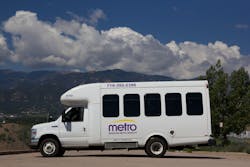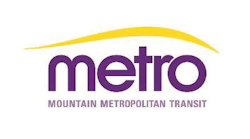Mountain Metropolitan Transit (MMT) in Colorado Springs, Colorado, provides fixed-bus service and ADA paratransit for people with disabilities and senior citizens in the Colorado Springs and and the Pikes Peak region. MMT began its paratransit service in 1993, following the passage of federal ADA legislation. MMT also works with other organizations.
"We also have additional community paratransit service that is provided by non-profit community organizations that also provide transportation for people who are disable and senior citizens," said Craig Blewitt, director of MMT. "It goes above and beyond what the ADA requirements are."
MMT has contracted service for its fixed-route, paratransit and fleet maintenance services. MMT's current paratransit contractor is National Express. "It’s something that Colorado Springs has always done, since 1972 when we started operating the public transit system. I know that different communities have different ways, but outsourcing has worked very well for us," explained Blewitt.
MMT worked to make its services as fluid as possible. Blewitt said they use the Trapeze software platform for trip planning on both its fixed-route and its paratransit system.
"I think that affords us some advantages."
Developing a Community Footprint
Blewitt explained that reaching rural areas is always an issue. "I think that there’s always going to be some unmet need and demand, but that’s one of the services that these other community organizations provide. They provide service outside of our ADA ‘footprint’ and also in some of the more rural areas outside of Colorado Springs."
Blewitt said that to provide the best service possible, MMT provides assistance for the other organizations that provide additional service. "We help fund those community non-profit organizations that provide those services. We do pay for some of their services out of our budget. They are complementing and supplementing our service and helping us provide a more holistic service to the community."
To asses the needs of the community Blewitt said that MMT includes an ADA coordinating plan in their regional transportation planning process.
"Part of that plan was an assessment of need. With some, such as senior citizens, that demographic information is readily available," said Blewitt. "For persons with disabilities there is some additional work that was done to asses needs and expect where we might have demand. It is an ongoing process. When we, or the organizations, get calls from folks, we try to track that and understand that on a year-to-year basis as we look at services."
Susan Richards, president of SR Concepts — a consulting firm that specializes in marketing products and services for public transportation systems — works with smaller communities to help in the development of transit operations, including paratransit. "You want people to know it’s available because it’s a needed service, and you want the people who need it to know about it — they need information about it, they need it to be attractive. We make sure that the materials that we do don’t separate people with disabilities from the general audience, we want it to look inclusive, but also make sure that they understand that the service is available to them."
Richards said that one of the most important things that she does when going into a community is not only to work with the agencies themselves, but also reaching out to other organizations, including churches. "Mostly I try to promote their transit more inclusively. Most of the time paratransit needs to be promoted with the facts; it’s not something that you go out and normally try to generate ridership on."
Richards said that she finds working with local organizations helps transit systems not only cover more ground, but can help with an issue that she finds transit agencies often face. Richards says that covering large territories can be a drain on funds and can be difficult to discover what needs people in and around the community have.
Adjusting Service to Fit Needs
When MMT first began in 1993, its paratransit fleet was relatively small, with just 10 buses. "Our fixed-route buses did not have wheelchair accessible ramps at that time. So since the ADA passage, we have made sure that our fixed buses did, initially they were lifts, and now of course their low-floor buses with ramps. We’ve also expanded our paratransit fleet to now where we have around 48 vehicles. We have expanded and we’re better meeting the needs of persons with disabilities."
MMT further developed its service by providing information technology. On the Colorado Springs government website there is a collection of ADA resources. People in need are able to request accommodations for situations, including program modifications, removal of barriers near bus stops or buildings, therapeutic recreation and additional accommodations. Besides being an offering for those that need the services, information on remaining ADA compliant during construction. MMT also began installing on-board technology on its paratransit buses in 2008.
Blewitt said, "it’s had an immediate, significant impact — about 30 percent increase in productivity."
Both Blewitt and Richards stressed the importance of paratransit in the community, and the importance of providing a service for those who need it. Especially in smaller communities, or communities that have outer-laying areas where people wouldn't normally have access to a fixed-route service. Blewitt said that MMT's paratransit and ADA operations have had a key impact to the Colorado Springs community.
"The majority of our paratransit rides go to jobs and schools and those are people in workforce or people who are preparing to be in the workforce. I just think that it is a critical connection for folks so they contribute to the community," explained Blewitt. "They can have personal fulfillment and also so that they can assist our community economy as well by having more people engaged."
When looking toward the future, MMT is planning to adjust its service to provide better coordination between its paratransit, fixed fleet and the additional community organizations that provide paratransit support to MMT.
"One of the key things that we’re doing in working with the non-profit organizations is that we’re starting a joint call center starting January 2, 2017," said Blewitt, "and we’re excited about that to better coordinate our services and gain more cost effectiveness, reduce in duplication and hopefully provide more rides for the dollar and better serve the community."




